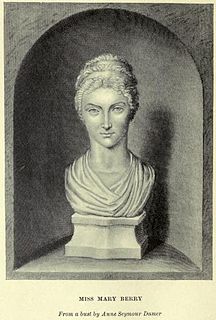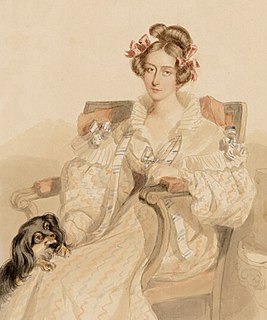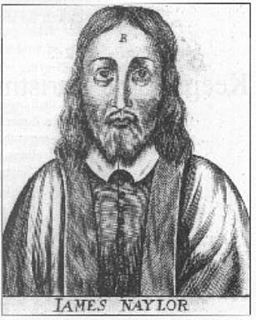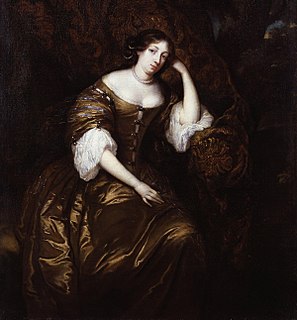 W
WMary Berry was an English non-fiction writer born in Kirkbridge, North Yorkshire. She is best known for her letters and journals, namely Social Life in England and France from the French Revolution, published in 1831, and Journals and Correspondence, published after her death in 1865. Berry became notable through her association with close friend Horace Walpole, whose literary collection she, along with her sister and father, inherited.
 W
WElizabeth Bowen Thompson born Elizabeth Maria Lloyd was a British educator missionary who founded the British Syrian Schools. Early on, she was brought under strong religious influences. After being widowed herself, she developed an affinity for the widows of the Crimean War, Indian Rebellion of 1857, and 1860 Mount Lebanon civil war, and provided them with support. Her simple and graphic letters narrated her life's work.
 W
WSir William Brereton, 1st Baronet, (1604–1661), was an English Puritan who owned extensive estates in Cheshire, and Member of Parliament for Cheshire county at various times between 1628 and 1653. During the First English Civil War, he was commander of Parliamentarian forces in the North Midlands.
 W
WRosina Bulwer Lytton was an Anglo-Irish writer who published fourteen novels, a volume of essays and a volume of letters.
 W
WPhilip Dormer Stanhope, 4th Earl of Chesterfield, was a British statesman, diplomat, man of letters, and an acclaimed wit of his time.
 W
WMary Delany was an English artist, letter-writer, and bluestocking, known for her "paper-mosaicks" and botanic drawing, needlework and her lively correspondence.
 W
WLucie, Lady Duff-Gordon was an English author and translator who wrote as Lucie Gordon. She is best known for her Letters from Egypt, 1863–1865 (1865) and Last Letters from Egypt (1875), most of which are addressed to her husband, Alexander Duff-Gordon, and her mother, Sarah Austin. Having moved in prominent literary circles in London, she contracted tuberculosis and migrated in 1861 to South Africa for health reasons. She travelled on to Egypt in 1862 where she settled in Luxor, learnt Arabic, and wrote many letters about Egyptian culture, religion, and customs. Her letters are notable for humour, outrage at the ruling Ottomans, and many personal stories from the people around her.
 W
WEmily Eden was an English poet and novelist who gave witty accounts of English life in the early 19th century. She wrote a celebrated account of her travels in India, and two novels that sold well. She was also an accomplished amateur artist.
 W
WHenrietta Louisa Fermor, Countess of Pomfret, was an English letter writer.
 W
WSir Rupert Charles Hart-Davis was an English publisher and editor. He founded the publishing company Rupert Hart-Davis Ltd. As a biographer, he is remembered for his Hugh Walpole (1952), as an editor, for his Collected Letters of Oscar Wilde (1962), and, as both editor and part-author, for the Lyttelton/Hart-Davis Letters.
 W
WPhilip Henry was an English Nonconformist clergyman and diarist. His son Matthew Henry was a notable commentator on the Bible and also a Presbyterian minister.
 W
WMary Hervey, Lady Hervey was an English courtier.
 W
WHarriett Hesketh or Harriett Cowper was an English letter writer, known for her correspondence with William Cowper.
 W
WJohn Keats was an English Romantic poet. He was one of the main figures of the second generation of Romantic poets, along with Lord Byron and Percy Bysshe Shelley, despite his works having been in publication for only four years before his death from tuberculosis at the age of 25.
 W
WHannah T. King was a British-born American writer and pioneer. Converting to Mormonism while in England, her family emigrated to the American state of Utah in 1853 where she became endeared to the people of that state. She was the author of Songs of the Heart, several poems, as well as writings addressed to young readers. King was the last woman sealed to Brigham Young.
 W
WHenrietta Knight, Baroness Luxborough, was an English poet and letter writer.
 W
WCharles Lamb was an English essayist, poet, and antiquarian, best known for his Essays of Elia and for the children's book Tales from Shakespeare, co-authored with his sister, Mary Lamb (1764–1847).
 W
WThe Hon George William Lyttelton was a British teacher and littérateur from the Lyttelton family. Known in his lifetime as an inspiring teacher of classics and English literature at Eton, and an avid sportsman and sports writer, he became known to a wider audience with the posthumous publication of his letters, which became a literary success in the 1970s and 80s, and eventually ran to six volumes.
 W
WSarah Churchill, Duchess of Marlborough, Princess of Mindelheim, Countess of Nellenburg, was an English courtier who rose to be one of the most influential women of her time through her close friendship with Anne, Queen of Great Britain. Sarah's friendship and influence with Princess Anne were widely known, and leading public figures often turned their attentions to her, hoping for favor from Anne. By the time Anne became Queen, Sarah’s knowledge of government and intimacy with the queen had made her a powerful friend and a dangerous enemy.
 W
WLady Mary Wortley Montagu was an English aristocrat, writer, and poet. Lady Mary is today chiefly remembered for her letters, particularly her letters from travels to the Ottoman Empire, as wife to the British ambassador to Turkey, which Billie Melman described as "the very first example of a secular work by a woman about the Muslim Orient". Aside from her writing, Lady Mary is also known for introducing and advocating for smallpox inoculation to Britain after her return from Turkey. Her writings address and challenge the hindering contemporary social attitudes towards women and their intellectual and social growth.
 W
WJames Nayler was an English Quaker leader. He was among the members of the Valiant Sixty, a group of early Quaker preachers and missionaries. At the peak of his career, he preached against enclosure and the slave trade.
 W
WDorothy Osborne, Lady Temple (1627–1695) was a British writer of letters and wife of Sir William Temple, 1st Baronet.
 W
WLord Sidney Godolphin Osborne was an English cleric, philanthropist and writer.
 W
WDorothea "Dolly" Ponsonby was an English writer and close friends of the Llewelyn Davies and du Maurier families. She was the mother of Elizabeth Ponsonby of the Bright Young Things.
 W
WRachel, Lady Russell was an English noblewoman, heiress, and author. Her second husband was William, Lord Russell, who was implicated in the Rye House Plot and later executed. A collection of the many letters she wrote to her husband and other distinguished men was published in 1773.
 W
WPleasance Smith was an English letter writer, literary editor, and centenarian. Smith lived to the age of 103, becoming well known in later life on account of her advanced years.
 W
WLady Louisa Stuart was a British writer of the 18th and 19th centuries. Her long life spanned nearly ninety-four years.
 W
WCatherine Talbot was an English author and member of the Blue Stockings Society.
 W
WJohn Wesley was an English cleric, theologian and evangelist who was a leader of a revival movement within the Church of England known as Methodism. The societies he founded became the dominant form of the independent Methodist movement that continues to this day.
 W
WCharlotte Williams-Wynn was a British letter-writer and diarist.